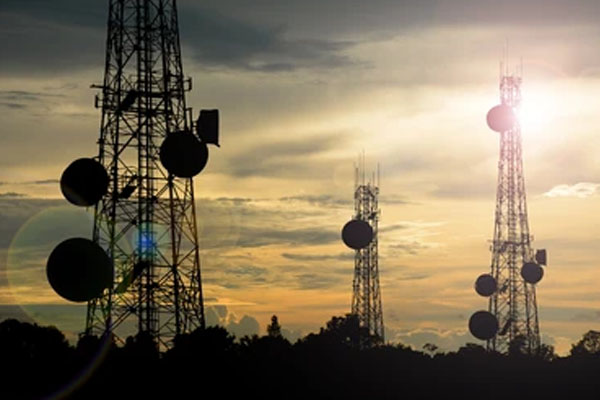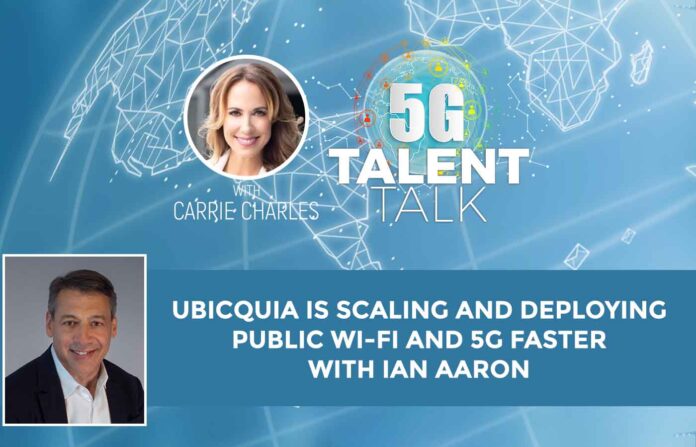Ubicquia is on a mission to create smarter, safer and more connected cities. Their solutions leverage existing infrastructure such as streetlights and utility poles to provide critical services to communities globally. Ubicquia makes scaling and deploying WiFi and 5G faster and more efficient.
Join Carrie Charles as she speaks with Ubicquia CEO, Ian Aaron and learn about the latest technology that is driving 5G and making a difference in our world.
—
Watch the episode here
Listen to the podcast here
Ubicquia is Scaling and Deploying Public Wi-Fi and 5G Faster with Ian Aaron
We have a special guest, Ian Aaron. He is the Founder and CEO of Ubicquia. Ian, thank you so much for joining me on the show.
Thanks so much. I’m looking forward to the talk.
I met you at an event and I heard you speak. I was a little bit distracted. I was doing a couple of different things, talking to the people, and all of a sudden, I heard you say a few things. I laser-focused on you and said, “I have got to get him on show.” Before we get into Ubicquia, tell me about your journey and how did you get to where you are?
My background is as an engineer and in business out of the University of Illinois. I started my career at GTE in all facets of the mobile and telecom industry. I’ve been running public and private tech companies for the past years, everything from workouts for Morgan Stanley to divisions for NewsCorp. I had some great success in taking early-stage technology and turning it into a significant business. That’s the opportunity that we saw here at Ubicquia.
I came to Ubicquia through a 40-year relationship with the chairman with who we went to high school together. It’s a great story. Ubicquia was going down a little different direction in the IoT space. I had a little different vision for the business and about years ago, I came on board with the support of the board and investors. I’m turning the company into something very unique.
It is very unique. Tell me all about Ubicquia, your product and what you do. I’m fascinated by this.
We like to say we’re in the intelligent infrastructure business. What makes us so unique is there’s been hundreds of billions, if not trillions of dollars of investment in infrastructure that’s already in the ground, whether it’s streetlights, utility poles, transformers, or the fundamental industrial components of cities and utilities. When you look at, as an example, the 5G space, the traditional model was, “Let’s put in new infrastructure. Let’s put a new fat pole. Let’s build.”
We took a step back and said, “There’s all this infrastructure. How do we leverage this to accelerate 5G? How do we leverage this to take existing transformers and distribution grids and make them intelligent? How do we leverage this to drive even things like energy savings?” that was the mission we started in the streetlight business. If you ever look at a streetlight, you have a streetlight every 50 meters. They are 8 to 10 meters high, so 25 to 30 feet high.
If you want to start doing something today in 5G, you need assets on the ground.
On that streetlight from every manufacturer, there’s a socket that has the photocell. That socket is universal on 360 million streetlights around the globe. Whether you’re in Australia, Japan, Germany, across the US, Latin America, Brazil, or wherever, it’s universal. We make products that plug into that photocell socket, and that’s where we started.
The first one we started is a little upside-down Dixie cup that plugs into the photocell socket, had saved cities 20% to 40%. In terms of energy in a city, their streetlight utility bill is one of their largest expenses in energy. We’re doing things that are helping cities and utilities, and then they’re able to take those savings and start to put them into other infrastructures such as public safety with more cameras or license plate readers, expanding public Wi-Fi, or even what we’re doing in 5G, working with people like Ericsson to help the carriers, densify 5G.
I’ve been driving around, looking at all these street lights and I think of you. I’m like, “I wonder if that’s one.” It’s a brilliant idea.
Now we’re deployed in more than 400 cities and utilities in a relatively short period of time. We have some major contracts that we’re going to be announcing that are already contracted. Our mantra in the company is, “Simply connected, simply smart.” When you look at a lot of these initiatives in industrial IoT, they require you to build out big networks. As with Cisco, you have to build out big mesh networks, which is what the utilities historically did.
We took a stance early on and said, “The carriers are going to be expanding Gg. The cost per megabyte over the years has kept declining. They’re building carrier utility class networks at the highest level of reliability. Why do you want to go and recreate the wheel?” It’s exciting in the position in our business because, on one side, we’re putting hundreds of thousands of devices every year on the network for the carriers. On the other side, we make products that leverage the infrastructure to help the carriers accelerate 5G. It’s a very exciting kind of place to be.
I was reading on your website that you are redefining the inspection process. Can you speak about that?
Are you talking about a permitting process or what we’re doing on the grid?
It could be both of those because I found that to be fascinating. Can you speak about both of them?

The other interesting thing to think about is years ago, the C band auction wasn’t done right. Millimeter wave auctions weren’t there, CBRS auction, all of a sudden in a very short period of time, you’ve got all this additional spectrum. Many of these are what we call the mid-band spectrum, and that requires more sites. When you think of a typical site, it’s 12 to 18 months in permitting and 4 to 6 months in construction. For the reality of 5G in both mid-band and millimeter waves, the U S is going to need several million small cells over the next five years.
The question is, “Can you do that, waiting 18 to 24 months for every site?” What we’ve ended up doing is we developed and collaborating with Ericsson. In fact, we did a pilot with AT&T. They thought it was such a game-changer. They said, “We want you to work with Ericsson and Nokia to deliver this solution.” I always like to show and tell. We have a product literally that plugs into the photocell socket in about 30 seconds. It can be activated in days. Everything that you see in a fat pole from the radio and antennas is all integrated into this power supply, except this, which is certified as a meter.
We also can tell the utilities how much energy is being used by the device and report it to them on a revenue grade basis, on a billing grade basis. Things like tilt and vibration. They understand the impact of weather on the polls. This is not what you have in a typical fat pole. We’ve done something incredibly unique if you look at the video on Ericsson’s site, they’ll tell you it’s a game-changer and that it is sold through Ericsson.
When people think of technology, there are a lot of great 5G products out there. The reality is the US carriers are primarily Ericsson and Nokia. You can wait for Iran, which was going to be years. You can look at all the different Mocha and Moran all the different technologies, but if you want to start doing something today, you need assets on the ground today, and you need compatible products today. That’s the beautiful meld of what we bring together.
How is this technology going to keep us safer and more connected?
First of all, by being able to put out more radios, obviously, you’re improving the network. I’m sure you’ve seen the situation where you have four bars. You have coverage, but you don’t necessarily have capacity. Capacity requires a higher density of radios. That’s all about what we’re doing. How that’s going to have to happen? We also make products in a similar fashion.
This happens to be a Wi-Fi six access point, but integrated into it is a dual 4K camera. It has integrated microphones in an eight-core neural AI processor. We use this in cities such as Dallas, Ontario, Miami-Dade and Schenectady, all over the country, where they’re using it for better management of traffic flows, pedestrian crossings, and pedestrian safety, using it inherently to expand public broadband.
There are numerous other cases of the fact that we do everything on edge. You’ve heard people talk about, “The cloud is moving to the edge.” We’re doing it. We’re leveraging the 360 million compatible street lights that are out there to do it. We even have a deployment that’s great in Hawaii that happened where the mayor is in the bucket truck, installing this in less than a minute.
Every city’s Wi-Fi needs to act as a Swiss Army knife for the city.
I’m excited that they’re going to be able to provide public Wi-Fi in areas where they couldn’t before. We look at many of our products like our small cell. It’s the small cell antenna power supply metering all integrated. Our Wi-Fi is the Swiss army knife for the city. It goes in as Wi-Fi, but you’ve got the AI for the cameras.
You have the audio integrated so that you can do congestion and other types of audio management, so audio reporting. What is also important, everything we do is on a single platform. When you see cities now, they have multiple vendors and then they have to have single panes of glass, other consultants and everybody to come in to try to integrate everything. Here because we’re LTE based, they can start with a basis 1 to 10 devices. They can grow it. They don’t have to build out private networks to do it. This is why we’re seeing so much interest in the product and it is scaling.
I’m sure that it’s such an exciting place to work. When we source for engineers, they always say, “I want something interesting, exciting. It’s about the project. It’s about what I’m up to.” It sounds like an incredible place and culture. Can you describe a little bit about the culture at Ubicquia?
First of all, culture’s always led from the top. I’ve been incredibly fortunate I made the decision to move the business to Fort Lauderdale because of the 4,500 people that are at Motorola. It was originally in Melbourne, Florida, the space coast, where there are brilliant engineers, but there’s a philosophical difference. When you’re on the space coast, you’re making five gold-plated devices that go on Mars for 30 years. We’re making carrier and utility grade devices scaled by the hundreds of thousands and millions as this business grows. The mentality of the team that we have from companies like, Motorola, Cisco and GE are helping to drive the innovation culture.
As it relates overall, there’s something about a company whose mantra is, “We make cities smarter, safer, and more connected.” When you see what’s going on with all of the DOE funding on grid resiliency, rural and public broadband, energy savings and public safety, everything in the news are products in the bullseye. There’s a culture here that people come in and they know that the products we’re making are saving cities money and those savings are giving them more money to put against broadband and public safety.
They’re seeing that while carriers have great balance sheets, they’re still looking at the most cost-effective way to scale, not just in dollars, but also did they do it more expeditiously in a shorter period of time. What’s been great about South Florida is have several intern programs, one with FAU, which I’m proud of, with Dean Stella Batalama, the Dean of the engineering schools.
We have quite a few engineering interns that come through and many of them convert to full-time. More than 50% of those that have come through have been women, with quite a few that have converted to full-time. We also have an intern program with Cincinnati School Design. We get some great talent for the industrial design team, and I’m also working on some other intern programs in different schools around the country.
Do you have any challenges with retaining talent or any strategies you can share working for you?

We realized upfront that we have to be competitive and there’s a cost for doing that, but it’s the right kind of investment. Everybody participates from the standpoint of RSUs. We’ve structured something where employees get it every year. It’s not a grant. Four years later, they got another grant. We have it as part of the normal compensation structure. We have a very comprehensive health and benefits program, which is very important nowadays. We’ve done the same thing with our 409, IRAs and other programs internally.
We’ve tried to look like a Facebook or Google to make sure we retain. When you look at our senior team, our COO was 25 years at Motorola as the corporate VP of all product development and engineering. Peter Aloumanis is a great connective tissue with the community, both in tech, research and education.
If you look at his entire senior team, they’re all twenty-plus years at Motorola. We have the same thing from Cisco in our finance and sales department, twenty-plus years experienced veterans. That kind of leadership fosters hiring great people. They say, “Why would somebody with that kind of experience be at this company?” When they started peeling the onion, they started understanding why.
Let’s look at the future. Tell me about your vision. Where is Ubicquia going to be in five years from now? What most excites you about the future?
What excites me is that we could put up several million devices and just be scratching the surface. Every product that we make is compatible globally. For us to take all the $100 million-plus of investment that went into creating these products, now we can start looking at taking them on a global basis, with just local certifications and local language, but I literally can take our products in 150 countries, ship them, plug them in, and they work. We’re working on strategies for how we start to drive growth for the company. With that said, I am an engineer. People like to say propeller head, but deep roots in products. We have a lot of exciting innovations in front of us.
That innovation is also going to drive obviously the need for more resources in different areas. We’re coming out with the millimeter wave repeater that’s going to help the carriers deliver on the dream of ultra-wideband and be able to do it installs in minutes and can start delivering better coverage or even fixed wireless access to users. What we’re doing in the grid business, it’s the first time at scale utilities can start monitoring the distribution network that our distribution transformers at scale. As we’ve been deploying at scale, the data and the AI around it have been incredible. We see significant hirings in data scientists and in our AI group across all facets of the business, whether it’s the smart city, connectivity or the grid.
We see with all the budgets and the funding for the next five years, whether it’s DOE grants for grid resiliency, broadband and rural broadband, tremendous opportunity, even with the core products. We’re building not only the sales team but channel programs to bring on channel partners all around our connectivity space.
We see a lot of exciting opportunities around private LTE, especially in the utility segment, as they start to convert from ISM band mesh to 5G. We’ve developed technology that allows us to go up on the public networks, then when utilities convert to private LTE, the products without having to go back up on the pole and convert over to the private network. So much of what we think about innovation isn’t just the hard technology. It’s the logistics.
Innovation isn’t just about the hard technology. It’s also about the logistics.
How are people going to do this at scale? How are the partners going to do it cost-effectively so they maintain their ROIs? Doing what we’re doing, we’re going to see growth in every facet of our business from hardware mechanical design, embedded software, AI application, absolutely on the sales side, as well as we start to expand internationally. We see a lot of exciting things in the next 3 to 5 years.
Whoever’s reading this show is probably thinking, “How can I work for Ubicquia? This sounds exciting.” I agree. Tell me your website and where to go to look for open jobs available.
We have postings on our website, which is Ubicquia.com. We have a great HR department. We have quite a few postings obviously on LinkedIn as well. Between those two, we typically post everything. We also have these intern programs. What I love about the culture is we’ve got seasoned executives who have been there and done this as far as building carrier utility, public safety, products for those industries at very high-quality levels and related products in the millions of devices. Bringing that kind of expertise and experience with great young talent has created a great culture and environment.
We’re open to other intern programs and other schools. I was on a plane, sitting next to a nice young gentleman who’s just going to temple and engineering. I gave him my card and I said, “We love great interns.” I could tell he was a sharp young man. He sent me a note. I connected him with our HR. Now we’re talking about a summer program for him.
It’s an honor to have you on the show. What you and your team have created, the innovation, is one of those things where I’m sure many people are thinking, “Why didn’t I think of that?” It’s brilliant. I cannot wait to see what you and your team are going to do in the future. I know that our paths are going to cross again. Thank you so much for being on the show.
Thank you. It was a great opportunity. I hope viewers out there start looking at streetlights a little differently. It’s a pleasure.
Important Links
About Ian Aaron
 Ian Aaron is the CEO of Ubicquia which develops and deploys intelligent street infrastructure platforms for utilities, municipalities, and communication service providers that deliver energy savings, enhance public safety, accelerate 5G deployments and harden the grid. Ubicquia’s platforms are compatible with more than 360 million streetlights, 500 million distribution transformers and 1 billion utility poles globally. Ubicquia has deployments in more than 425 cities across the US, Canada, and Latin America.
Ian Aaron is the CEO of Ubicquia which develops and deploys intelligent street infrastructure platforms for utilities, municipalities, and communication service providers that deliver energy savings, enhance public safety, accelerate 5G deployments and harden the grid. Ubicquia’s platforms are compatible with more than 360 million streetlights, 500 million distribution transformers and 1 billion utility poles globally. Ubicquia has deployments in more than 425 cities across the US, Canada, and Latin America.
Aaron is a 25-year global C-Level executive with operational and strategic experience at the intersection of telecom and technology. Aaron has served as CEO and President of public and private companies including Gemstar TV Guide (NASDAQ: GMST), TVN Entertainment, SoftNet Systems (NASDAQ: SOFN) and Director and Executive Chairman of Pictometry. Aaron’s operating expertise includes building and managing global product development, engineering, and sales teams, leading $1 billion in public and private financings and $3.5 billion in exits.
Aaron graduated from the University of Illinois with degrees in Electrical Engineering and Communications. In 2022, Ian was named EY’s “Entrepreneur of the Year” for Florida and is a regular contributor to Forbes Technology Council. He began his career in R&D and Product Development at GTE residing both domestically and in Japan and currently resides in Fort Lauderdale, FL.
Love the show? Subscribe, rate, review, and share!
Join the 5G Talent Talk Community today:

